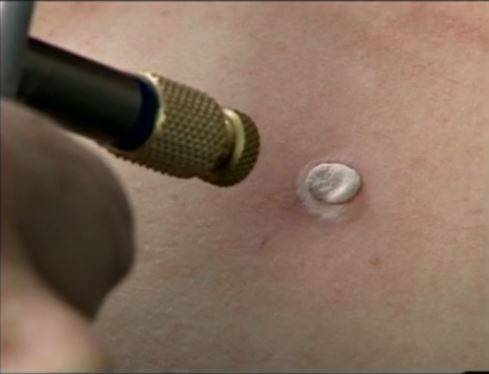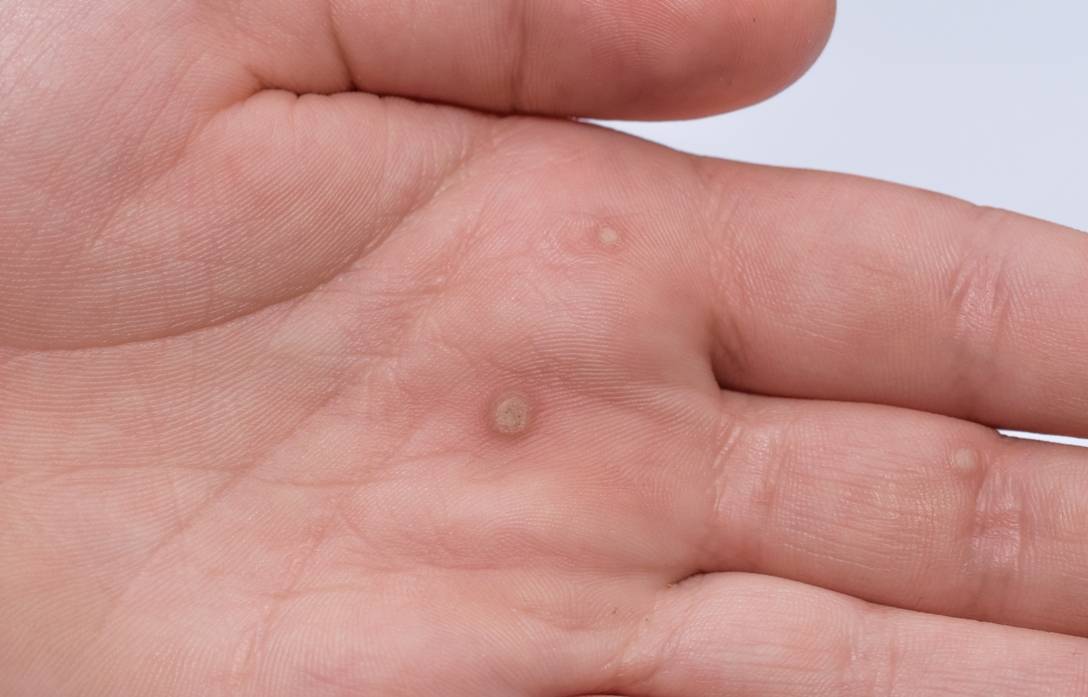What is Cryotherapy?
This article describes the use of cryotherapy (often also called cryosurgery) for the treatment of skin conditions in primary care. The word ‘cryosurgery’ is derived from Greek, meaning ‘icy cold handiwork’, which quite appropriately summarises this treatment as, the skilful application of extreme cold to the skin.
Liquid nitrogen is now by far the most common refrigerant used to produce the degree of cold needed. Advantages of liquid nitrogen include its extremely low temperature of -196 degrees
Centigrade, as well as its widespread availability and ease of storage.


For optimal results, the abnormal area of skin needs to be frozen to a sufficiently low temperature for long enough; as well as being frozen widely and deeply enough. The aim is to cause enough freezing to ensure sufficient cells are killed, whilst minimising any damage to the deeper or surrounding normal skin. We then rely on the body’s ability to heal its self, in order to return the treated area to as normal an appearance as possible after the skin
problem has been removed.

At a microscopic level, cryotherapy is believed to work in a number of ways. Temperatures of -6 to -10 degrees cause cell death as a result of the action of genes inside the cells. When an abnormal area of skin is frozen even colder, to a temperature of between -20 to -40 degrees Centigrade, ice crystals will form inside and around the cells. These cause cell damage during freezing and thawing. Some hours after cryotherapy, there is also damage to very small blood vessels in the treated area. Cryotherapy may also cause a reaction of the body’s immune system.


In primary care, the two most common methods to apply liquid nitrogen to the skin are using a hand-held spray or cotton-buds. Using the spray method can produce much lower treatment temperatures, it is better for treating larger areas and easier to control the amount of treatment given. A shield may be used to protect the surrounding normal skin from unnecessary freezing. The cotton-bud method involves repeatedly dipping the bud into a small pot of liquid nitrogen and pressing it onto the skin lesion. Good success rates are achieved using both methods, though the spray method is more powerful and
more versatile.
Over-the-counter cryotherapy treatments are available to the public. However these self-treatments usually only achieve a temperature about one third as cold as a liquid nitrogen spray.


In primary care, cryotherapy is usually only used to treat benign conditions, because there may be difficulties in accurately diagnosing, ensuring adequate treatment, and following-up the premalignant or malignant skin diseases.

By far the most common use of cryotherapy is for the removal of viral wart infections. These are mostly seen in children and include common warts (most commonly found on the face, hands and knees) and verruca infections on the soles of the feet. About two-thirds of warts (and an even higher proportion of verruca infections) will actually disappear without any treatment within 2 years. Cryotherapy is often used, when a faster rate of clearance is desired; or when patients have not been successful using wart paint. In theory, wart paint treatment and cryotherapy should be equally successful (about 70% cleared by 3 months for both methods). However, in order to be effective, wart paint needs to be applied every night, after carefully filing down any hard skin with an emery board nail file or pumice stone. In practice, many patients find this too difficult to do thoroughly enough to be successful. Cryotherapy for a wart or verruca may need 3 - 4 treatment sessions, at 2 - 3 weekly intervals.
Molluscum contagiosum is another very common viral infection of the skin, which is mainly seen in children under the age of 10. There may be very few, or very many white, yellow, or brown spots, which are 1 - 6 mm in diameter, have a rounded shape, and have a small dimple at their tops. Cryotherapy can be useful to more rapidly clear this infection, as once again, without any treatment the problem usually clears very slowly
(in half of the patients by 12 months and in two-thirds by 18 months).
Cryotherapy is also very useful for treating a number of other common skin conditions, though these treatments may be considered to be ‘cosmetic’ by medical insurance companies and therefore not be covered by them. Skin tags (usually found on the neck, armpits, or groin area) respond well to cryotherapy. Seborrheic warts, which are very common on the skin of Caucasians as they grow older; as well as plane warts, can also be treated very well by cryotherapy.


Before any cryotherapy to lesions on the fingers, it is essential that any rings be removed first.
Where the liquid nitrogen is sprayed, there will be some stinging pain during freezing and thawing. Pain can start again a few hours afterwards, and a pain-killer medicine (such as paracetamol or ibuprofen) is sometimes needed. To prevent pain during cryotherapy, an anaesthetic cream can be applied 1 - 2 hours before treatment. This can be especially useful when treating children.
Within hours of treatment, some redness and swelling are expected, and very often a blister will form. The blister may contain clear fluid, or in some cases blood (especially when verruca infections are treated). There may be some oozing of fluid from the area, which can last for several days and a simple dressing may need to be applied. Blisters may, if necessary be punctured to let the fluid out. This can be done, using a needle that has been sterilized by being passed through a flame. Puncturing the blister can be repeated until the blister no longer refills. Depending on the area of the body that has been treated, about 5 days to several weeks after treatment, the dried-out blister or dead skin will separate and come off. A further scaly crust may then form on the wound.


An important complication is incomplete removal or recurrence of a treated skin lesion. As many conditions require more than one liquid nitrogen session, your doctor’s instructions on the need for any follow-up are important.
Cryotherapy, for benign skin problems usually gives excellent to very good cosmetic results, however permanent, depressed or raised scars can rarely occur. Increased redness of the treated area is quite common, but usually resolves with time. Cryotherapy can occasionally cause a lighter coloured patch in the treated area, and this can be permanent. Infection can occur sometimes (more likely after multiple areas have been treated, or on softer skin areas). Delayed healing may occur, especially after treatment on the lower legs. Sensation may very rarely be affected due to damage to nerve endings or nerve branches, though this often improves with time. On hairy areas of skin, treatment usually leads to a permanent loss of hair growth in the treated area.
In summary, cryotherapy is a very useful and successful treatment option in primary care clinics. However, it is certainly not appropriate for all skin lesions. Other treatment options (including in some cases no treatment at all) need to be carefully considered. Seeing the doctor again is important if a skin lesion that has been treated persists or recurs.
Get In Touch
For any enquiry, please call +852 3420 6622, Whatsapp +852 5228 0810, or info@marinamedical.hk

Web Design by YSD


